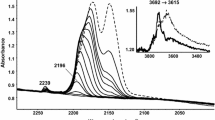Abstract
Isopropanol conversion over commercial nickel-kieselguhr catalyst is studied. It is found that using this catalyst allows the single-step production of acetone (in contrast to familiar two-step technologies) with a catalyst not been previously used in this process in a range of moderate temperatures with a feedstock conversion of 97% and a target product yield of 82.4%. Changes that occur in the phase composition, surface structure, and electronic properties of the nickel catalyst under the action of the reaction medium are studied via scanning electron microscopy, thermal analysis, X-ray diffraction, and conductometry. It is shown that the conversion of isopropanol into acetone through the dehydrogenation reaction is accompanied by a loosening of the initial homogeneous globular structure of the catalyst to form nickel nanoclusters. Active sites in the alcohol conversion reactions are nickel ions in different states of oxidation and cationic and anionic vacancies.
Similar content being viewed by others
References
Reznik, I.D., Ermakov, G.P., and Shneerson, Ya.M., Nikel’ (Nickel), Moscow: Nauka i Tekhnologiya, 2003.
Arutyunov, V.S. and Krylov, O.V., Russ. Chem. Rev., 2005, vol. 74, no. 12, pp. 1111–1137.
Shalin, R.E., Svetlov, I.L., Kachalov, E.B., Toloraiya, V.N., and Gavrilin, O.S., Monokristally nikelevykh zharoprochnykh splavov (Single Crystals of Nickel Refractory Alloys), Moscow: Mashinostroenie, 1997.
Kostromina, N.A., Kumok, V.N., and Kumok, N.A., Khimiya koordinatsionnykh soedinenii (Chemistry of Coordination Compounds), Moscow: Vysshaya Shkola, 1990.
Semenistaya, T.V. and Shagisultanova, G.A., Zh. Neorg. Khim., 2003, vol. 48, no. 4, pp. 602–610.
Physical Metallurgy, Cahn, R.W. and Haasen, P., Eds., Amsterdam: Elsevier, 1983.
Volkov, V.A., Vonskii, E.V., and Kuznetsova, G.I., Vydayushchiesya khimiki mira. Bibliograficheskii spravochnik (Outstanding World Chemists: A Bibliographic Handbook), Moscow: Vysshaya Shkola, 1991.
Zamaraev, K.I., Kinet. Katal., 1980, vol. 21, no. 1, pp. 36–52.
Sokol’skii, D.V. and Zakumbaeva, G.D., Adsorbtsiya i kataliz na metallakh VIII gruppy (Adsorption and Catalysts on Group VIII Metals), Alma-Ata: Nauka, 1973.
Maksimov, A.L., Kuklin, S.N., Kardasheva, Yu.S., and Karakhanov, E.A., Pet. Chem., 2013, vol. 53, no. 3, pp. 157–163.
Potekhin, V.M. and Potekhin, V.V., Osnovy teorii khimicheskikh protsessov tekhnologii organicheskikh veshchestv i neftepererabotki (Theoretical Foundations of Chemical Processes in Organics Technology and Oil Refining), St. Petersburg: Khimizdat, 2005.
Navalikhina, M.D. and Krylov, O.V., Russ. Chem. Rev., 1998, vol. 67, no. 7, pp. 587–616.
Egubaev, S.Kh., Katal. Prom-sti, 2001, no. 2, pp. 24–32.
Gladky, A.Yu., Ustugov, V.V., Sorokin, A.M., Nizovskii, A.I., Parmon, V.N., and Bukhtiyarov, V.I., Chem. Eng. J., 2005, vol. 107, nos. 1–3, pp. 33–38.
Krylov, O.V., Geterogennyi kataliz (Heterogeneous Catalysis), Moscow: Akademkniga, 2004.
Ermakov, Yu.I., Zakharov, V.A., and Kuznetsov, B.N., Zakreplennye kompleksy na oksidnykh nositelyakh v katalize (Immobilized Complexes on Oxide Supports in Catalysis), Novosibirsk: Nauka, 1980.
Wen, X., Li, R., Yang, Y., Chen, J., and Zhang, F., Appl. Catal., A, 2013, vol. 468, pp. 204–215.
Li, H., Xu, Y., Gao, C., and Zhao, Y. Catal. Today, 2010, vol. 158, nos. 34, pp. 475–480.
Kurina, L.N., Galaktionova, L.V., Guseinova, E.A., and Adzhamov, K.Yu., Azerb. Khim. Zh., 2010, no. 3, pp. 116–119.
Guseinova, E.A. and Adzhamov, K.Yu., Russ. J. Phys. Chem. A, 2011, vol. 85, no. 11, pp. 1965–1970.
Guseinova, E.A., Abbasov, Ya.A., Adzhamov, K.Yu., and Ismailov, E.G., Russ. J. Phys. Chem. A, 2011, vol. 85, no. 1, pp. 141–145.
Guseinova, E.A., Agaguseinova, M.A., and Adzhamov, K.Yu., Abstract of Papers, Trudy II RossiiskoAzerbaidzhanskogo simpoziuma s mezhdunarodnym uchastiem “Kataliz v reshenii problem neftekhimii i neftepererabotki” (Proc. II Russia-Azerbaijan Symposium with International Participation “Catalysts for Solving the Problems of Petroshemistry and Oil Refining”), St. Petersburg, 2013, p. 78.
Taylor, K.N.R. and Darby, M.I., Physics of Rare Earth Solids, London: Chapman & Hall, 1972.
Wolkenshtein, T., Electronic Processes on Semiconductor Surfaces during Chemosorption, New York: Consultant Bureau, 1991.
Kiselev, V.F. and Krylov, O.V., Elektronnye yavleniya v adsorbtsii i katalize na polyprovodnikakh i dielektrikakh (Electronic Phenomena in Adsorption and Catalysis on Semiconductors and Dielectrics), Moscow: Nauka, 1979.
Panchenkov, G.M. and Lebedev, V.P., Khimicheskaya kinetika i kataliz (Chemical Kinetics and Catalysis), Moscow: Khimiya, 1974.
Ugai, Ya.A., Vvedenie v khimiyu poluprovodnikov (Introduction to Semiconductor Chemistry), Moscow: Vysshaya Shkola, 1965.
Chebotin, V.N., Fizicheskaya khimiya tverdogo tela (Physical Chemistry of Solids), Moscow: Khimiya, 1982.
Kofstad, P., Nonstoichiometry, Diffusion, and Electrical Conductivity in Binary Metal Oxides, New York: Wiley, 1972.
Terminologicheskii spektr fiziki: Slovar’ (Spectrum of Physical Terms: A Dictionary), Mazunov, V.M., Vasil’ev, Yu.V., and Kantor, E.A., Eds., Ufa: Ufimsk. Gos. Neft. Tekhn. Univ., 2005.
Drozdov, A.A., Zlomanov, V.P., Mazo, G.N., and Spiridonov, F.M., Neorganicheskaya khimiya. Khimiya perekhodnykh elementov (Inorganic Chemistry. Chemistry of Transition Elements), Tret’yakov, Yu.D., Ed., Moscow: Akademiya, 2006, vol. 3, part. 1.
West, A.R., Solid State Chemistry and Its Applications, New York: Wiley, 1985.
Kröger, F.A., The Chemistry of Imperfect Crystals, Amsterdam: Elsevier, 1964.
Author information
Authors and Affiliations
Corresponding author
Additional information
Original Russian Text © E.A. Guseinova, E.T. Zeinalov, K.Yu. Adzhamov, 2015, published in Kataliz v Promyshlennosti.
Rights and permissions
About this article
Cite this article
Guseinova, E.A., Zeinalov, E.T. & Adzhamov, K.Y. Commercial nickel-kieselguhr isopropanol dehydrogenation catalysts: Morphology and catalytic and electronic properties. Catal. Ind. 7, 227–233 (2015). https://doi.org/10.1134/S207005041503006X
Received:
Published:
Issue Date:
DOI: https://doi.org/10.1134/S207005041503006X



